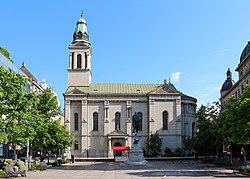Serbian Orthodox Cathedral, Zagreb
| Serbian Orthodox Cathedral in Zagreb | |
|---|---|
| Cathedral of the Transfiguration of the Lord Храм преображења Господњег Hram preobraženja Gospodnjeg | |
 | |
| 45°48′46″N 15°58′26″E / 45.81265°N 15.9739°E | |
| Location | Zagreb |
| Country | Croatia |
| Denomination | Serbian Orthodox |
| Previous denomination | all Eastern Orthodox communities |
| History | |
| Former name(s) | Church of St. Peter and Paul (in 1794) |
| Status | Church |
| Founded | |
| Dedication | Transfiguration of the Lord |
| Past bishop(s) | Metropolitan Emilijan Marinović (1969–1977) Metropolitan Jovan Pavlović 1982-2014 |
| Architecture | |
| Functional status | Active |
| Heritage designation | Register of Cultural Goods of Croatia |
| Architect(s) | Franjo Klein and Hermann Bollé |
| Style | Historicist interpretation of Romanesque and Byzantine architecture |
| Administration | |
| Archdiocese | Metropolitanate of Zagreb and Ljubljana |
The Cathedral of the Transfiguration of the Lord (Serbo-Croatian: Храм преображења Господњег, Hram preobraženja Gospodnjeg) is a Serbian Orthodox cathedral located on the Petar Preradović Square in Zagreb, Croatia. It was built in 1865–66 according to designs of architect Franjo Klein. It is ecclesiastically part of the Metropolitanate of Zagreb and Ljubljana and is known as the Zagreb Orthodox Cathedral. Due to 2020 Zagreb earthquake the Cathedral went to re-construction due to mayor damages that occurred.
History
[edit]Old St. Marguerite church
[edit]A wooden Catholic church dedicated to St. Marguerite was located on the place of the modern day cathedral in the 14th century.[1] The church was restored in the 16th and 17th century.[1] Between 1372 and the 19th century, the annual St. Marguerite fair was organized on the square.[2] In the 18th century the church was burned down in a fire and in its place a new one was built with bulbous steeple.[2]

Duding the Josephinism period the state implemented significant reforms that affected life of religious communities. In 1781 Patent of Toleration extended religious freedom to non-Catholic Christians living in Habsburg lands and was followed by 1782 Edict of Tolerance. By city government decision the old church was offered at auction and sold to the Zagreb Croatian Orthodox Parish for 4,000 florins.[1] In 1848, during Revolutions of 1848, the Orthodox Parish added the suffix Serbian in its name since by that time the Serbs (under the autonomous Patriarchate of Karlovci) significantly outnumbered local Greeks and Aromanians.[1]
Construction of new church
[edit]
In 1861 initiative was launched to build new church on the site of a dilapidated old St. Marguerite church.[2] Project was awarded to the architect Franjo Klein. In the same period when the Serbian Orthodox Cathedral was built, Zagreb Synagogue was also built according to the Franjo Klein project.[2] Church was completed on 21 October 1866, and synagogue on 27 September 1867.[2]
In 1897, after completion of urbanization of square south to the church, architect Hermann Bollé proposed plan of monumental reorganization of church.[2] This plan was never implemented, but the same architect developed a plan for restoration of bell tower in its modern-day shape in 1899, and in 1913 based on his plan façade was restored.[2]
World War II
[edit]During World War II collaborationist Croatian Ustaše regime of Independent State of Croatia seized all property Serbian Orthodox Church and determined that the cathedral would be the central church of Croatian Orthodox Church, which was a part of the widespread Genocide of Serbs in the Independent State of Croatia.
Architecture
[edit]
The iconostasis was placed in front of the altar in 1795.[1] This iconostasis was donated to Church of St. George in Varaždin in 1884 when the current iconostasis was built.[1] The iconostasis of the Orthodox Cathedral comprises a total of 34 icons and 4 free-standing walnut pillars.[1] The Metropolitan Jovan Pavlović, who reigned from 1982 to 2014 was buried in the cathedral after his death in 2014.[3]
Gallery
[edit]-
Church at night
-
Icons frescos on the walls
-
View of the Cathedral from Ilica street
See also
[edit]- Zagreb Cathedral
- History of Zagreb
- Orthodoxy in Croatia
- Serbs of Croatia
- Kantakuzina Katarina Branković Serbian Orthodox Secondary School
- List of Serbian Orthodox churches in Croatia
References
[edit]- ^ a b c d e f g Pravoslavna crkva na preradovićevom trgu, PhD Dragan Damjanović, Zagreb-moj grad, pages 11-13, Issue 28, year IV, May 2010
- ^ a b c d e f g Preradovićev (Cvjetni) trg-ogledalo urbaniteta, PhD Snježana Knežević, Zagreb-moj grad, pages 4-9, Issue 28, year IV, May 2010
- ^ Blic. "U Sabornom hramu u Zagrebu sahranjen mitroplit Jovan" (in Serbian). Retrieved 2 May 2015.
Bibliography
[edit]- Преображени храм (Живопис храма Св. Преображења Господњег у Загребу)-Храм преображенный (Роснись храма св. Преображенуя Господня б Загребе)-Transfigured church (Fresgues of the church of St. Transfiguration of the Lord in Zagreb), Irina Buseva Davidova and Dragan Damjanović, Zagreb 2008, trilingual publication in Serbian, Russian and English, NSK CIP 673785
External links
[edit]![]() Media related to Cathedral of the Transfiguration of the Lord in Zagreb at Wikimedia Commons
Media related to Cathedral of the Transfiguration of the Lord in Zagreb at Wikimedia Commons
- Cathedrals in Croatia
- Churches in Zagreb
- Serbian Orthodox church buildings in Croatia
- Serbian Orthodox cathedrals
- Donji grad, Zagreb
- Metropolitanate of Zagreb and Ljubljana
- 19th-century Serbian Orthodox church buildings
- Churches completed in 1866
- 1860s establishments in Croatia
- 1866 establishments in the Austrian Empire
- Hermann Bollé buildings
- 19th-century churches in Croatia














